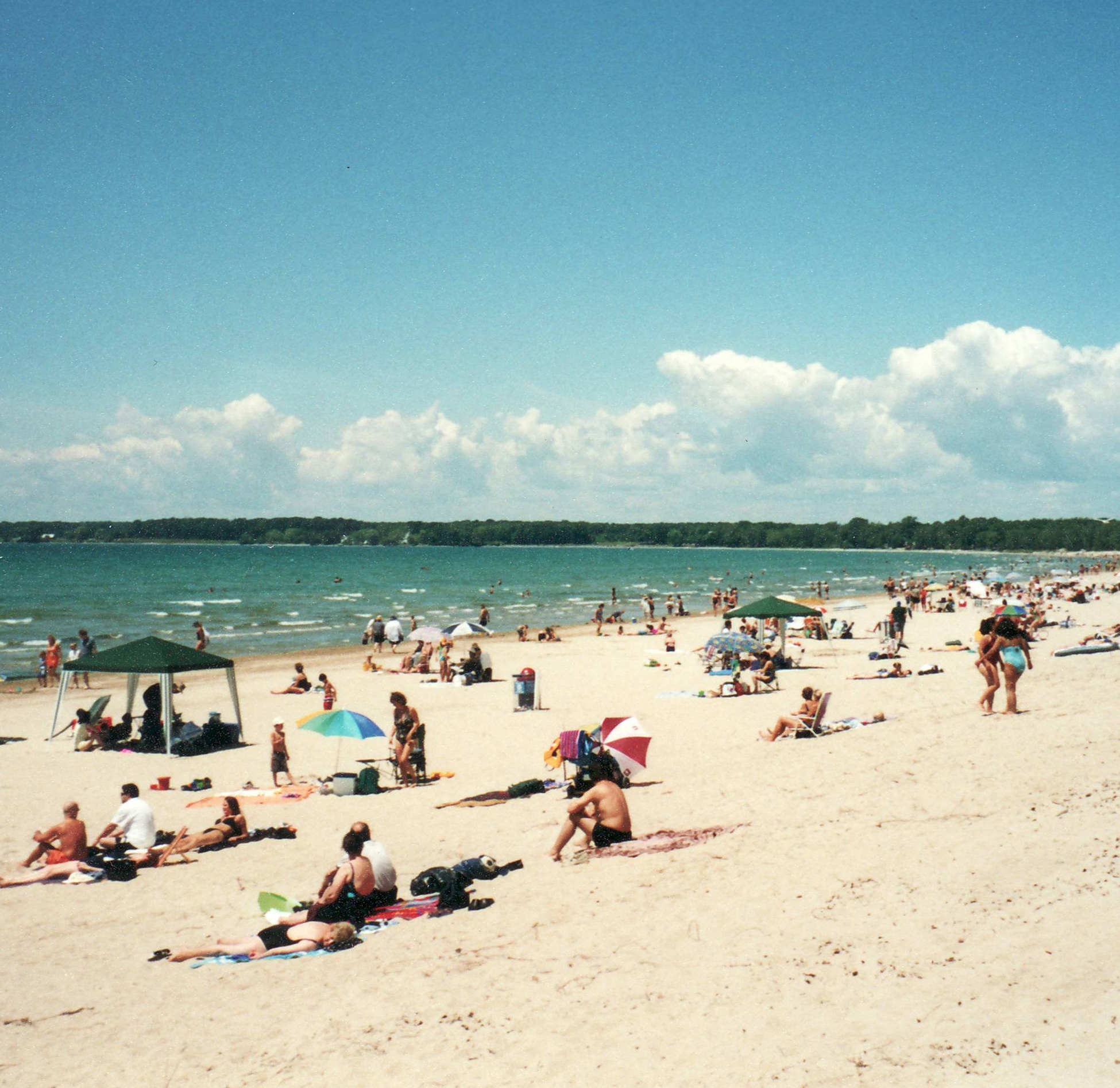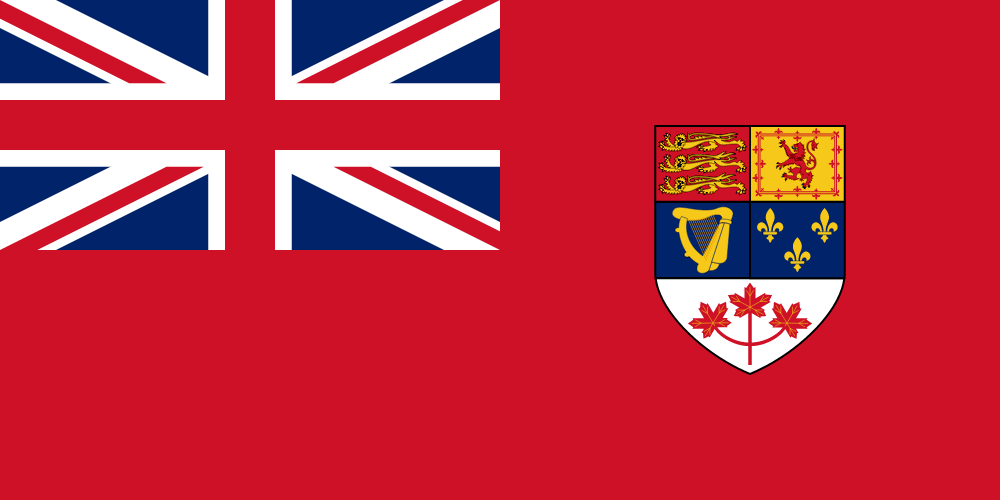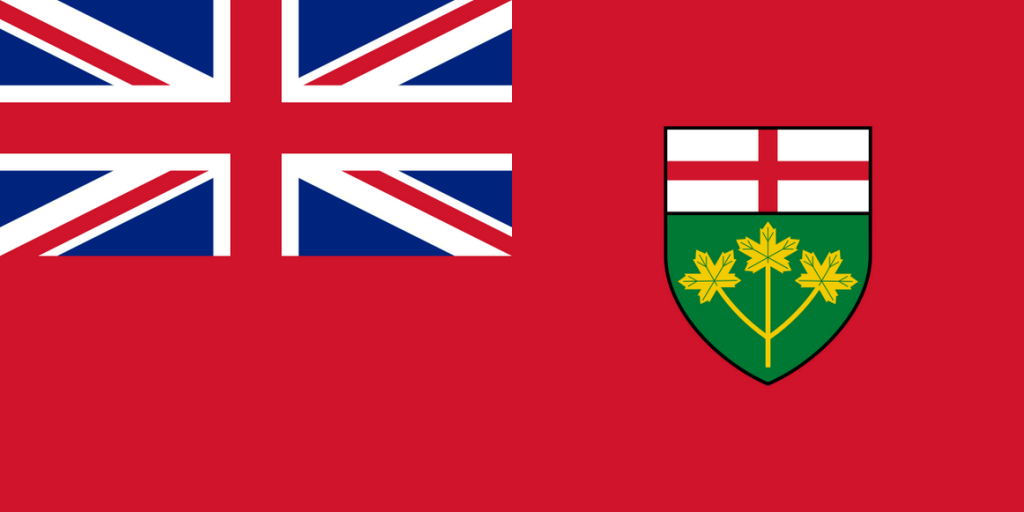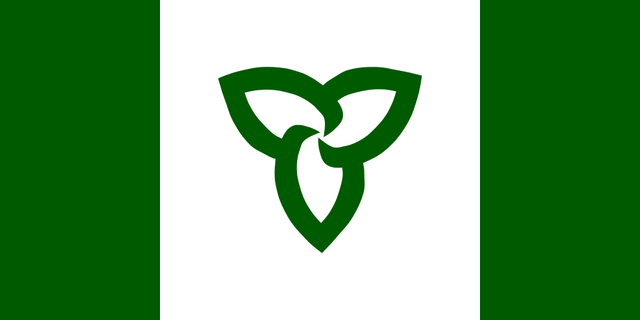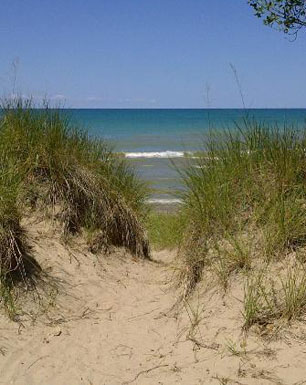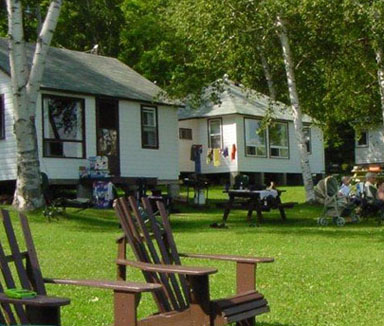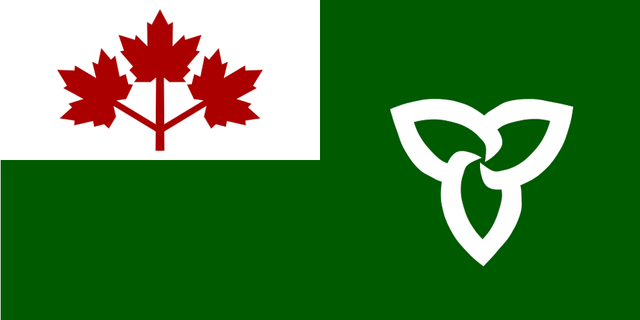Ontario’s flag flap 2015 .. and its own burden of history from just before (and after) the War of 1812
Jun 22nd, 2015 | By Counterweights Editors | Category: In Brief
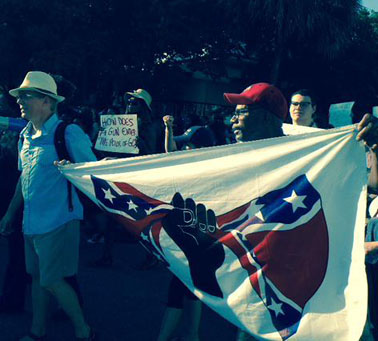
“Near the front, a black man held a banner with an image of a black fist crumpling a Confederate flag. Just past the Mother Emanuel church, a white man picked up one of the corners, and they carried it toward the museum together.”
Questions have been raised about the Confederate flag still flying over the South Carolina state capitol, even after the appalling terrorist prayer-meeting murders in Charleston this past Wednesday night. They may remind some of us north of the Great Lakes that a few much milder questions were raised about the current Ontario provincial flag last month.
Of course, of course, the current Ontario flag is not remotely comparable to the old flag of the politically short- lived Confederate States of America, which was defeated in the American Civil War (1861—1865).
Just to start with, Ontario’s flag only goes back to 1965. Peter Price, who teaches in the history department at Queen’s, explained all this in the Toronto Star last month. The flag, Mr. Price wrote, “was designed as a reactionary response to the new Canadian maple leaf flag that Lester Pearson’s Liberal government introduced to replace the old Red Ensign. When Ottawa brought in the new Canadian flag, with its bold colours and distinctive maple leaf, supporters of the old ensign turned to the provincial government to give it a renewed life. Ontario’s Conservative government led by John Robarts adopted the flag on May 21, 1965 to bring back what Ottawa had removed three months earlier: a flag with a clear British connection.”
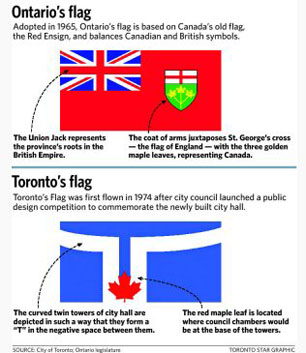
Comparison of current Ontario and Toronto flags, devised by someone at the Toronto Star, for Edward Keenan’s column : “Who needs Ontario when we’ve got Toronto?”
Ironically enough, only six days before Peter Price’s article appeared in the Toronto Star, on Wednesday, May 13, 2015, the Liberal Member of the Ontario Legislative Assembly for the Toronto riding of Etobicoke Centre, Yvan Baker, had introduced a private member’s bill, proposing “that May 21st in each year be recognized as Ontario Flag Day.”
As explained by Mr. Baker’s website : “The Bill’s introduction came just one week prior to the 50th anniversary of the first raising of Ontario’s flag on May 21st, 2015 and helped to commemorate this historic anniversary.”
Meanwhile, Peter Price’s article, which appeared on May 19, 2015, concluded on a much more critical note : “The 50th anniversary of Ontario’s official flag gives pause to consider whether the hastily adopted British ensign still suits the province today. More than anything, the complacency about the flag and the largely unnoticed passing of its anniversary reflects the weakness of provincial identity and the dimness of its symbols … Is it worth celebrating the anniversary of Ontario’s flag? Probably not, but it is certainly worth asking why not.”
(Oh and btw, the ultimate plot behind this article here, by we counterweights editors, is to introduce the next installment of Randall White’s current book project, Children of the Global Village – Canada in the 21st Century : Tales about the history that matters. If you go to our Long Journey to a Canadian Republic page, on the bar at the top above or just CLICK HERE, you will find a brief account of the project, along with the “Prologue : too much geography” – followed by links to the six chapters in Part I. More or less in keeping with what might be called the deepest origins of the current Ontario flag flap, you will now find as well a link to Part II, Chapter 1 :“The new northern British America in the late 18th and early 19th centuries.”)
1. The Ontario flag flap, May 20—June 6, 2015 … A play in four acts
For those paying very close attention, the Peter Price article about the Ontario flag in the Toronto Star stimulated a few intriguing responses after its publication on May 19 :
I. Â MAY 20 – On his TV Ontario blog the dean of provincial politics journalists Steve Paikin asked : “Is it time for a new flag for Ontario?”And he reported :”Though I wouldn’t describe it yet as a widespread movement, there is a group of citizens who would like to see Ontario’s Red Ensign replaced. They say the presence of the Union Jack doesn’t speak to the nearly 60 per cent of Ontarians who don’t describe their origins as either English or Scottish … Roberto Martella, the proprietor of Grano Restaurant on Yonge Street, is the driving force behind a new flag. He doesn’t have a particular design in mind, other than it “be inclusive of all views, as inclusive as a Province whose reality is vastly different today than it was 50 years ago when the Ontario Flag was cobbled together by Premier Robarts as a paean to perceived ‘lost empire.’”
II. Â MAY 20 – Meanwhile, back in the pages of the Toronto Star, city issues columnist Edward Keenan was urging : “Happy flag anniversary, fellow Ontarians! As readers of Peter Price’s column in the Star’s opinion pages on Wednesday learned, May 21 marks 50 years since our province adopted the modified red ensign as our official flag … To which I imagined many readers looked up from their newspapers and said, “Huh. Ontario has a flag?”… Well, not much of a flag, Price’s essay showed; ours is a relic of stubborn loyalty to the British empire adopted hastily in ‘revenge’ for Prime Minister Lester B. Pearson’s introduction of the Maple Leaf. A red field with the provincial seal of arms on it and a Union Jack in the top corner. A flag that is hard to tell apart from Manitoba’s, so lacking is it in distinction …Which is appropriate. Because as Price hints toward the end of his piece on the flag Ontario “deserves,” this is a province without much in the way of identity.”
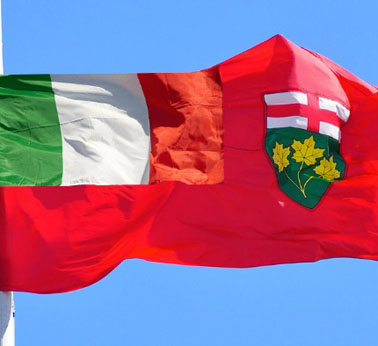
Roberto Martella, proprietor of Grano Restaurant on Yonge Street and a Canadian of Italian heritage, has jocularly suggested this as a replacement for the current Ontario flag.
III. MAY 21 – On the actual day of the Ontario flag’s 50th anniversary, the young Ottawa journalist Dean McRobie posted a piece called “#TBT: Ontario adopts a ‘revenge flag,’” on the influential ipolitics (Canada) website,. Mr. McRobie noted Premier Robarts’s decision to adopt a revised version of the old red ensign, after the Pearson Liberals (and Douglas New Democrats and even Diefenbaker Conservative Members of Parliament from Quebec) had adopted the new independent maple leaf flag for Canada as of February 15, 1965. And Mr. McRobie further noted : “On May 21, 1965, the Ontario legislature voted 106-2 to approve Robarts’ flag; one of the two dissenters charged that the design – adopted three months after federal abandonment of the Red Ensign – was a ‘revenge flag’ aimed at Pearson’s project … Fifty years later, Ontario’s ‘revenge flag’ is attracting controversy for the same reason the old Red Ensign once did: it is too British for some.”
IV. JUN 6 – Some two weeks after the official flag anniversary, the Toronto Star’s Queen’s Park columnist Martin Regg Cohn had digested the controversy sufficiently to offer some wise overarching advice on the broader issues involved, in a piece headlined “How Ontario travelled back in time as Canada moved forward.”
Mr. Cohn started with a specific question : “Fifty years ago, then-premier John Robarts chose the Union Jack as a symbol for our new provincial flag …Today, that flag flies in the face of our diversity – its design unheralded, its anniversary unmarked, its inspiration utterly unoriginal. Like our flagging monarchy and segregated schools for Catholics, it is an anachronism that defines Ontario’s political culture of inertia … Is it time to lower the flag on our copy-cat British ensign?”
In trying to answer this question Martin Regg Cohn was understandably drawn to the bigger, deeper background : “The British monarchy,” he wrote, “ is in malaise – out of date and out of place in Canada, but difficult to dislodge. Just as our old Union Jack ensign could be confused for the British flag, so too Canadian postage stamps showing the Queen as our head of state are an anachronism … But when I covered Australia’s ill-fated referendum on ridding itself of the monarchy in 1999, I watched voters quarrel over what would replace the Queen. The lesson is that you first need to marshal public opinion toward a durable consensus … Â As Ontario becomes less Loyalist and more modernist, demographic shifts will drive democratic change. In time.”
And then Mr. Cohn returned to his initial specific question : “Change Ontario’s flag? It’s hard to fathom a grassroots revolt when no one even notices it flying overhead … Perhaps in a decade or two our fluttering flag will falter, just as the monarchy and other anachronisms will crumble under the weight of their own contradictions. Until then, irrelevant she remains.”
2. Meanwhile, back at the Legislative Assembly of Ontario

Liberal MPP Yvan Baker (back row, left) with some schoolchildren he recruited in his riding to wave Ontario flags, in celebration of Ontario Flag Day.
It says a great deal about what ails Ontariario nowadays that three days before Martin Regg Cohn’s flag piece appeared in the Toronto Star, Yvan Baker’s private member’s bill on the Ontario flag sailed through a legislature already looking forward to summer holidays.
We quote from an article dated June 3, 2015 on Mr. Baker’s website : “Today, Bill 101, An Act to Proclaim Ontario Flag Day, passed with the unanimous support of all Members of Provincial Parliament in the Legislative Assembly of Ontario.”
The article goes on : “The legislation, first introduced on May 13th, 2015 by Etobicoke Centre MPP Yvan Baker, proclaims that May 21st in each year be recognized as Ontario Flag Day. The Bill’s introduction came just one week prior to the 50th anniversary of the first raising of Ontario’s flag on May 21st, 2015 and helped to commemorate this historic anniversary.”
Mr. Baker himself declared : “This legislation will help highlight this important emblem that represents all Ontarians and will encourage all Ontarians to celebrate our rich history, diverse heritage, distinct values, and shared successes as a province.”
3. An exercise in Orwellian doublethink of quite astounding proportions
Whatever else, here at least is more hard evidence of Ontario’s political culture of inertia, and the weakness of provincial identity and the dimness of its symbols.
Just for instance, had none of those in the Ontario legislature who gave unanimous consent to the Ontario Flag Day bill on June 3 bumped into the  views on such matters put forward in various mass and other media only days before by any of Peter Price,  Steve Paikin, Roberto Martella, Edward Keenan, or  Deane McRobie?
Similarly, from the perspectives offered by these observers in such places as Canada’s most widely read newspaper, Ontario’s public television station blog, and a leading Canadian political website, the Preamble to “An Act to proclaim Ontario Flag Day” finally amounts to an exercise in Orwellian doublethink of quite astounding proportions.
It goes through Ontario’s “rich history and diverse heritage” in broad outline and then altogether unbelievably declares that “the Ontario flag symbolizes each of these contributions as well as our rich history, diverse heritage, distinct values and shared successes. The Ontario flag represents all those who call Ontario home.”
This is akin to the argument that the British monarchy is a crucial bulwark of Canadian democracy (which some otherwise sensible individuals have sometimes imagined can pass as a credible case for hanging on to the British monarchy in Canada today!).
The current Ontario flag certainly does not represent any of us here who have called Ontario home for more years that we can collectively count without the aid of machines. And a political culture that expects those who share it to take such palpable intellectual nonsense even half-seriously is consigning itself to a kind of Alice-in-Wonderland universe at best.
4. The debate that needs to be happening now
As far as we’re concerned as well, it finally doesn’t work to say that “As Ontario becomes less Loyalist and more modernist, demographic shifts will drive democratic change … Perhaps in a decade or two our fluttering flag will falter, just as the monarchy and other anachronisms will crumble under the weight of their own contradictions. In time.”
It is certainly true that we are not yet ready, in Ontario or Canada at large, to start dealing altogether practically with such still unresolved essentially constitutional questions as the future of the British monarchy in Canada, Senate reform, Quebec in confederation, the rights of the aboriginal peoples of Canada, and even flags for such provinces as Manitoba and Ontario.
But we need to be quite seriously debating these issues now, to marshal public opinion toward the kind of durable consensus on such matters that Martin Regg Cohn has wisely argued must precede successful action. This won’t happen if the mainstream media keeps trying to confine this kind of debate to some point in the future that has not yet arrived.
And at least helping to start this kind of debate, Randall White told us from a park bench at the beach yesterday afternoon, is exactly what he is trying to do in his current Children of the Global Village book project.
Chapter 1 of Part II, on “The new northern British America in the late 18th and early 19th centuries,” is especially concerned to clarify the roots of the Loyalist tradition in Ontario and other parts of English-speaking Canada.
As with the Ontario flag, Mr. White urges, the truth behind all this has always been, demographically at any rate, considerably thinner than the old “Britannic nation” legends have traditionally made out. (Ontario’s Loyalist motto, eg, was only invented in 1909 – 125 years after the real-world history it is supposed to be celebrating.) We would be less confused by our history. Mr. White says, if we knew more about what it has really been!
